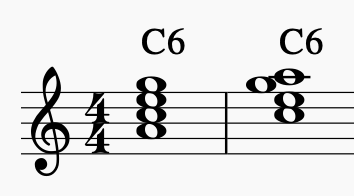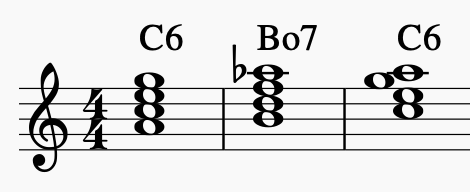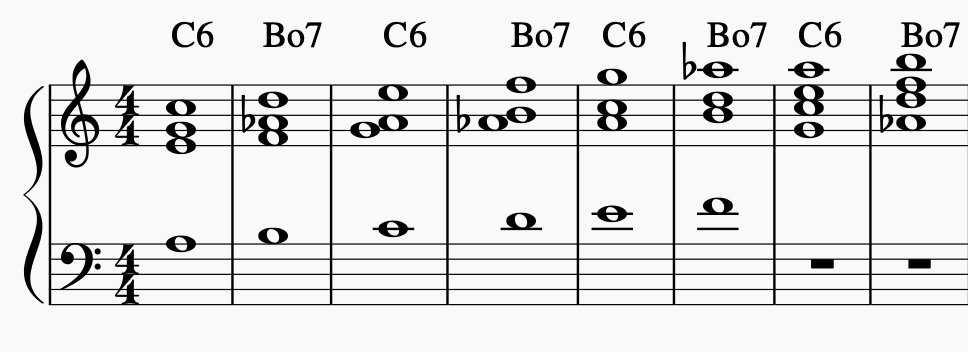The Pippinpotato Corner All things pippin and potato
Barry Harris Sixth Diminished Scale
8 minute read

The Barry Harris sixth diminished scale is a useful system for harmonizing major and minor scales. You’ll find it extremely useful and a great addition to your repertoire. The concept that it’s built on—resolving diminished chords—is very prevalent in both jazz and classical playing.
The System
The Barry Harris sixth diminished scale is a system for attaching chords to each note of a major or minor scale. Here is the C major sixth diminished scale.

There are a couple things to notice. The first is that going up the scale, you’re alternating between a diminished chord and a major chord, in this case C6 and Bo7. This is what gives the Barry Harris sixth diminished scale its characteristic sound. If you read my article about diminished chords, you’ll be aware of the relationship between diminished chords and dominant chords. Diminished chords are substitutes for dominant chords. Therein lies the essence of the Barry Harris sixth diminished scale. Let’s examine the Bo7 of the C major sixth diminished scale.
Bo7 can be renamed as Abo7, which is a substitute chord for G7, which is the dominant chord of CMaj7. What we’re essentially doing is turning a scale into a I-V-I-V-I… progression. Each note/chord on the scale resolves into the next, and so forth.
The second thing to notice is that the notes of the scale aren’t the same as the notes of the traditional C major scale. Stripped away of the chords, here are the notes of the scale.

We have an extra Ab in here. The reason for this is the I-V-I chord movement that defines the sixth diminished scale. If the scale were to just go from G to A, it would be going from C6 to C6.

I-I is not compelling chord movement. By adding the Ab, we’re adding a note that is part of the Bo7 chord and will give us our nice sounding I-V-I chord movement.

The third thing is that we are using C6 chords instead of CMaj7. The reason is also related to the I-V-I chord movement. Think about what would happen if we were to use CMaj7 instead of C6. Try harmonizing the entire scale. You can’t. When you reach the Ab, you realize you can’t harmonize the A because it isn’t in the chord of CMaj7 or Bo7.

However, there is an A in C6, hence why we use C6 instead of CMaj7 and why it’s called the sixth diminished scale instead of the seventh diminished scale. Notice that you don’t run into any trouble using CMaj7 instead of C6 for the lower parts of the scale, so this is definitely an option if you want to.
There is a small workaround if you’re intent on using CMaj7 for the entire scale. Remember that the essence of the Barry Harris sixth diminished scale is the I-V-I movement. You can preserve this by removing the Ab and adding a rootless G7 voicing of your choosing for the A. Now you preserve I-V-I chord movement everywhere in the scale except from B to C. Pretty good.

It’s not really the Barry Harris sixth diminished scale anymore, but it maintains the same harmonic spirit.
With the information here, you should be able to construct the minor sixth diminished scale yourself.
Finding the Diminished Chord
To find the correct diminished chord, just go down a half step from the root of the scale and create a diminished chord from there. For example, for the C major sixth diminished scale, a half step down from C is B, so you use B diminished 7 in the scale.
Voicings
You can really voice the sixth diminished scale anyway you want, but there are some easy go-to ways to go about it.
Locked Hands
Locked hands voicing is just doing block chord voicing and adding the melody note an octave below, on the bottom of the chord.

I like to play either the bottom note with my left hand and block chord with my right hand or the melody note with my right hand and block chord with my left hand; one hand plays one note, and the other hand plays the other four notes.
Drop-2
Drop-2 voicing is where you take the block chord voicing and drop the second note from the top an octave down, hence drop-2.

I play the bottom note with my left hand and rest of the chord with my right hand.
In Practice
The Barry Harris sixth diminished scale is great for melodies that have a lot of stepwise movement, aka diatonic seconds. We’re looking for stepwise movement because we want the sound of the I-V-I chord movement, which happens between adjacent notes of the scale. The sixth diminished scale you choose to use for each situation depends on the current chord.
Major and Minor Chords
For the major 7, major 6, minor 7, or minor 6 chord you just use the corresponding sixth diminished scale. Let’s take an example of a sixth diminished scale over a major 7 chord from the beginning of “There Will Never Be Another You” with locked hands.

Here is a great place to use the sixth diminished scale because of the stepwise movement in the melody. Since the current chord is EbMaj7, we can use the corresponding sixth diminished scale: Eb major sixth diminished scale.
Let’s look at another example from “There Will Never Be Another You” with a minor 7 chord.

I use the sixth diminished scale for the first three notes of this example. Since it’s a C-7 chord, we use the C minor sixth diminished scale.
Dominant Chords
Using the sixth diminished scale over dominant chords is a little different than over major and minor chords. We could try using it in the same way, but I don’t think it sounds as good.

The notation looks a bit horrendous, but it’s just the diminished scale in the first measure. I’m using the F dominant diminished scale.

Notice how the 6th degree (D) isn’t found in either Eo7 or F7, so we’re employing the same method we talked about earlier, where we substitute in a rootless voicing of the V of F (C7).
This works, but I don’t think it sounds as good. The sixth diminished scale is reliant on the I-V-I motion, and although we get that here, it’s not as convincing. The I should be a place of rest, but our I here is a dominant seventh chord, which inherently has a lot of tension. F7 isn’t a very restful location. F7 wants to go to Bb6, so we should let it do that.
Instead of building the sixth diminished scale with F7 as the I, we should use F7 as the V. So over this F7 chord we end up using the Bb major sixth diminished scale (I choose the major sixth diminished scale here because of the D-natural in the melody).

Any Diatonic Seconds
In all the examples above, we use the sixth diminished scale over runs of three or more stepwise movements. However, these runs of diatonic seconds aren’t always present in the music. In reality, you can use the sixth diminished scale with any interval of a diatonic second as long as it goes from V to I in the sixth diminished scale. Let’s look again at the C major sixth diminished scale.

The diminished chords (V) fall on the scale degrees 2, 4, b6, 7. This means that if the diatonic second starts on any of those scale degrees, you can use the sixth diminished scale. Here is an example from “Like Someone In Love.”

I’m using the sixth diminished scale for the last two notes of the first measure and the first two notes of the second measure. The last two notes of the first measure are the scale degrees b6 then 6, and the first two notes of the second measure are the scale degrees 4 then 3. With the sixth diminished scale, they both create the V-I movement we’re looking for.
Final Note
The Barry Harris sixth diminished scale is essentially a series of I-V-I reharmonizations built into a scale. It’s a great way of adding more moments of tension and release into your playing. You can also use this concept to create your own version of the sixth diminished scale, where you can use different rootless voicings in place of the V to hit different notes on the scale.
Written on July 17th, 2020 by Chris Cheung